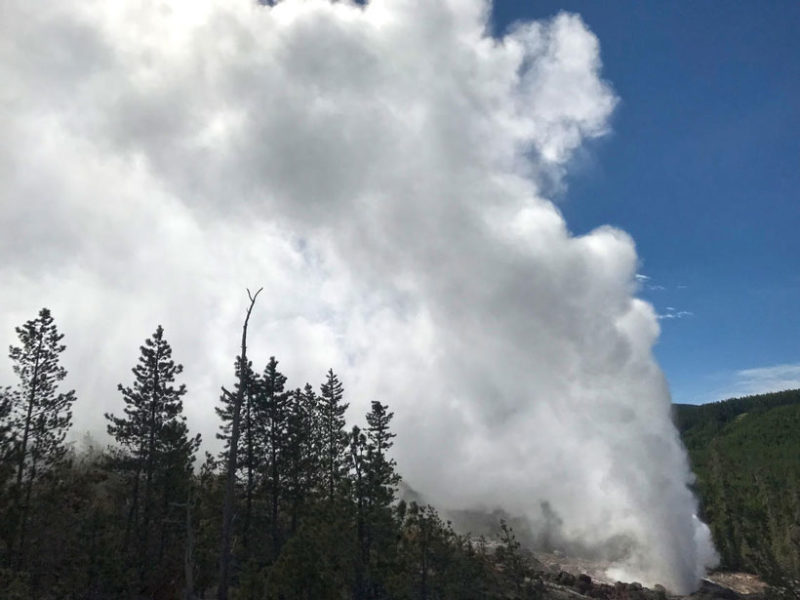
Yellowstone caldera is a geologic wonderland. It is the source of three of the largest explosive eruptions in the past 3 million years. The caldera itself covers over 1,500 square kilometers (580 square miles) in the northeast corner of Wyoming. As Charles Wicks from the U.S. Geological Survey (USGS) puts it, "Yellowstone's roots seem to extend all the way to the core-mantle boundary. In that dimension, it's a magmatic system of continental scale."
The Yellowstone caldera is packed with geothermal features like geysers, hot springs, mud pots, and geothermal pools. This hydrothermal activity is driven by the vast reservoirs of heat beneath the Yellowstone area, most of which comes from the magma found many kilometers underneath the caldera. All this heat and water mean the land surface at Yellowstone rises and falls frequently, meaning Yellowstone is best described as a "restless caldera."
Modeling a Deformation
A new study by Wicks and colleagues in the Journal of Geophysical Research: Solid Earth examines this restless behavior to try to understand what drives the deformation and how it might be linked to Steamboat Geyser. It turns out that the rising and falling of the land, the behavior of some geysers, and the introduction of new magma underneath Yellowstone could all be linked.
The north rim area and caldera floor at Yellowstone have been deforming for decades. The ability to monitor this deformation has greatly improved with GPS and interferometric synthetic aperture radar techniques. Wicks and others looked at the North Rim Uplift Anomaly (NRUA) and used deformation data from these techniques to model potential sources of these changes.
Magma, volatiles released from magma, or hydrothermal fluids could all cause the surface to rise or fall. Wicks and others used data from 2000 to 2018 to examine how much the NRUA either inflated or deflated. What they found is that the deformation in the NRUA may represent the accumulation of magmatic volatiles from a basaltic intrusion that occurred around 2000.
Steamboat Geyser might be a pressure gauge for these intrusions and accumulations of volatiles. The geyser is in the midst of one of its most active periods on record, having erupted 79 times (as of 20 May) since late 2018. This activity appears to correlate with the deformation cycle in the NRUA, which to Wicks suggests a connection between the cause of the deformation (magmatic volatiles) and Steamboat Geyser.
Small Sample Size
Mike Poland, scientist-in-charge of the USGS Yellowstone Volcano Observatory who was not involved in the study, thinks that the connection is more complicated: "Why would just a single geyser respond to processes beneath Norris [Geyser Basin]? Wouldn't that impact all the geysers?" One explanation might be that Steamboat Geyser likely has a more complex and deeper system than many geysers at Yellowstone.
Wicks admits that so far, scientists have a limited data set for Steamboat Geyser. "With only two episodes of observed deformation near Norris, the eruption frequency appears to respond to the surface deformation. Of course, that's a very small sample size, so the apparent connection might be happenstance." Any connection between Steamboat Geyser's activity and accumulation of gases near the surface could heighten the risk of hydrothermal explosions, one of the most significant geologic hazards for tourists visiting the national park.
Wicks suggests that the ability to have constant geochemical monitoring of the hydrothermal fluids from geysers and hot springs would help scientists create more accurate models: "Continuous monitoring of volatile flux rates are really needed to put the geophysical models in context. If surface inflation is caused by accumulation of pressurized fluids and deflation occurs when those fluids escape to the surface, we might be able to detect changes in volatile flux over time."
The ability to link deeper processes like magmatic intrusion with surface phenomena is tantalizing for geoscientists monitoring an active caldera like Yellowstone. Wicks and Poland both agree that understanding the connection between the magmatic and hydrothermal systems at Yellowstone is fundamental for better hazard models. They might end up being more directly linked than geoscientists have previously thought.
— Erik Klemetti (@eruptionsblog), Science Writer and Associate Professor of Geosciences, Denison University, Granville, Ohio
Citation: Klemetti, E. (2020), Are geysers a signal of magma intrusion under Yellowstone?, Eos, 101, https://doi.org/10.1029/2020EO144621. Published on 29 May 2020.



R.C.